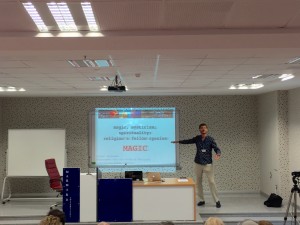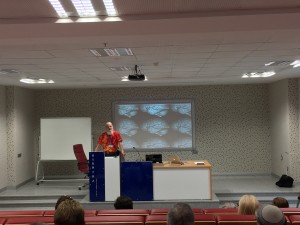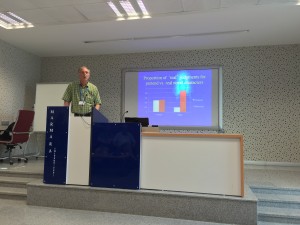The International Association for the Psychology of Religion (IAPR) 2015 World Congress was held on August 17th-20th. Conference report for The Religious Studies Project by Alex Uzdavines, a PhD student at Case Western Reserve University.
It’d be too much to say that I finally “get” horizontal transcendence (Coleman, Silver, & Hood, In Press), but I certainly got a horizontally transcendent experience at the IAPR 2015 World Congress in Istanbul, Turkey. Obviously, I was on a boat. It might have been related to the truly international collection of researchers discussing fascinating things (shop talk and otherwise) while enjoying a flagrantly stunning day on the Bosphorous. Although on reflection, the sea-sickness meds probably didn’t hurt. Regardless, there were several points along the way where I found myself disconnected, floating for a moment in a sense of overwhelming peace and happiness. Of course, I might have also been primed for this experience by a symposium the day before, which stuck (and has continued to stick) in my mind.

One could almost describe the first invited symposium of the conference, organized by Heinz Streib, as magical, although not the kind I usually deal with. Magic, Mysticism, Spirituality: Religion’s Fellow Species delivered exactly what was promised, as series of interesting talks on areas which are both components of and discreet from religion more broadly. After an introduction by Dr. Streib which outlined both the usefulness and problems with using prototypical categories like the ones dealt with in the symposium, Jesper Sørensen outlined his work in fractioning the idea of magic. He discussed both the discreet components of what it is (people have a goal with doing it, the causal mechanism is opaque, ritualized, etc.) and that before we can synthesize these components together to study magic as a whole, we need to develop and explore hypotheses about the discreet components. For instance, when thinking about ritual behavior one component might be a need to negate strong causal expectations or develop weak ones. He used the ritual of Christian Communion as an example, “There’s no intuitive schema for why eating bread leads to grace,” but the ritual surrounding the cracker consumption develops a causal link where there otherwise might not be one. For me, this discussion highlighted the furor surrounding the desecration of a communion wafer by PZ Myers, and perhaps explained some of the underlying cognitive reasons behind it.

symposium from the APA Division 36 mid-year conference. It also, in some ways, ran counter to Sørensen’s discussion of the need to explore the individual components of higher-order factors before working with the factors themselves. Of course, much of this has to do with what one means by, “reductionism.” Nevertheless, Hood described the push to make the psychology of religion fit into mainstream psychology by jettisoning many of the variables and ideas unique to religion and theology. Instead early researchers framed the sub-field using the same variables as the rest of psychology, but with some being more salient within a religious context than others. In doing so, the field might have lost out on exploring some of the more ineffable experiences that are associated with mysticism. This jettisoning is reflected in a lack of critical history among the current crop of handbooks on the psychology of religion and spirituality. They don’t discuss the tensions and interplay between the fields of psychology and theology which have led to the current state of the psychology of religion.
The final talk, presented by Streib, dealt with the semantics of spirituality and his work exploring the subfactors which may comprise this construct. He presented the results of several principal component analyses on data derived from a content analysis of open responses from roughly 1700 Germans and Americans on what they considered to be, “spirituality.” The participants had a wide range of belief identifications within the religious, spiritual, and nonreligious spectrum, allowing Streib and the other researchers to get a wider range of meanings than what might be found in a purely theistic sample. The PCAs generated ten different subfactors nested along three higher-order axes and, when taken together, define the range of meanings which grew out of their content analysis of the qualitative data. In particular, I was interested in how the three axes worked to explain some of the tension which can occur when trying to stitch together the definitions of “spirituality” generated by both believers and nonbelievers. In particular, the axes Mystical vs. Humanistic Transcending (something beyond, higher self) and Theistic vs. Nontheistic Transcending (higher power(s), part of religion) seem to be a big step towards shaving off some of the “fuzz” which often surrounds findings that rely on measures of “spirituality” which don’t take into account that different people can come at that term from very different meanings.
However, the big issue that was (and is) still in my mind after these three talks was the idea of supernaturalism vs. naturalism and the tensions between these that Hood raised. Here, Sørensen’s work seemed to be placed firmly within the realm of the naturalistic by breaking magic down into the cognitive processes that go into the beliefs surrounding it. Yet this doesn’t seem to be hitting on the “ineffable” components that may be unique to religion and mystical experience, which magic certainly seems to be a part of. Similarly, the two axes presented by Streib (which I discussed here) seem to imply a dichotomy of spirituality that is supernaturalistically versus naturalistically derived. Most of the constructs he presented seemed to sit more on the side of the “supernatural” with “natural” spirituality seemingly defined more in opposition, similarly to how theistic nonbelief is defined mostly in opposition to or as absence of theistic belief, rather than being a thing within itself. In effect, is it possible that people who identify as “neither religious, nor spiritual,” yet experience similar feelings of connectedness to those who identify as “spiritual,” have just removed the “spirit” component which implies the supernatural, while still retaining the other components of the term? It’s hard to say, but I’m looking forward to seeing more work (and producing some myself!) to try and figure this out.

My particular focus on this symposium came out of its relationship to my own work and what I feel are some of the major discussions going on in our field rather than out of lack of other fascinating talks to cover, not to mention the boat trip. However, several examples pertaining to nonbelief and nonbelievers can be found in Thomas Coleman’s forthcoming report for the Nonreligion and Secularity Research Network Blog. Further, due to travel difficulties among the other presenters, Peter Hill gracefully carried an entire symposium on measurement with a discussion of his work generating a scale to measure Intellectual Humility and Paul Harris’ keynote about how children only seem to come to believe in magical and miraculous thinking when they have a religious upbringing (as opposed to magical and miraculous thinking being native) is worthy of its own discrete report.
The academic quality of the conference alone was strong enough to make this one of the best conference experiences in my career so far. However, given the stunning beauty of the location, the warmth and kindness of our hosts from Marmara and İzmir Katip Çelebi Universities and the Center for Islamic Studies (special mention going to Kenan Sevinç both for much of the photography throughout the conference and helping me navigate a Turkish pharmacy so I could go on the boat trip), I suspect this conference will stand out in my memory for a long time to come.

References
Coleman, T. J. III, Silver, C. F., & Hood, R. W. Jr. (In Press). “…if the universe is beautiful, we’re part of that beauty.” – A ‘Neither Religious nor Spiritual’ Biography as Horizontal Transcendence In Streib, H. & Hood, R. (Eds.) The Semantics and Psychology of Spirituality. Dordrecht, NL: Springer. doi: 10.1007/978-3-319-21245-6_22


